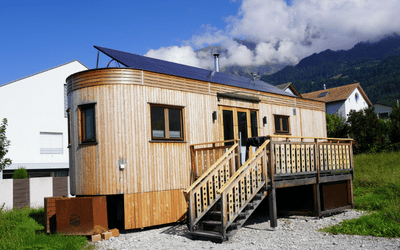Overview
STEM careers
Grade level
Time
Introduction
Tiny homes are one way to address both the need for sustainable housing and address climate change. Tiny homes are anything from a 64-square-foot lockable room with no bathroom or kitchen to a two-bedroom, complete house on wheels that hooks up to electric, water, and sewer connections at RV parks. Some people stay in them temporarily, while others set them up to be their permanent homes, offices, or guest rooms. Tiny homes are versatile and work for many different purposes.
- Tiny houses are also an opportunity to address climate change by:
- Designing a house that is net zero (meaning it generates all of the energy the occupants will use)
- Using new environmentally friendly materials and techniques to make construction more cost-effective and efficient
Building houses that protect people from the hazards of climate change (extreme heat, drought, and storms) are just three ways tiny homes can address climate change.
To succeed, every aspect of the tiny home needs to be engineered with energy efficiency in mind. And a net zero tiny house that can be easily replicated contributes to the solving of the worsening housing crisis. We are also at a point when energy efficiency and sustainability in construction are both critical—and possible! Engineers have already created the materials, technology, and systems for making every new dwelling environmentally friendly and energy neutral, if not energy negative.
Your STEM Project:
Design the structure and systems for a replicable, zero-energy tiny home that addresses the dual challenge of housing shortages and climate change.
Download Instructions & Project Management Templates
Challenge Instructions
Project Management Templates (Word version)
Research Resources
- What is a Zero Energy Building?
- Environmental benefits of tiny homes and sustainable construction
- Tiny homes help solve the housing crisis
- Design guidelines for a Net Zero Tiny House
- A student-designed zero-net energy Tiny House
- A commercial net-zero Tiny Home Design
- Tips for net zero energy efficiency
Academic Standards & UN Sustainable Development Goals
This project meets the following Next Gen Science Standards:
- HS-LS2-7 Ecosystems: Interactions, Energy, and Dynamics
Design, evaluate, and refine a solution for reducing the impacts of human activities on the environment and biodiversity.
- HS-ESS3-2 Earth and Human Activity
Evaluate competing design solutions for developing, managing, and utilizing energy and mineral resources based on cost-benefit ratios.
- HS-ETS1-2 Engineering Design
Design a solution to a complex real-world problem by breaking it down into smaller, more manageable problems that can be solved through engineering.
- HS-ETS1-3 Engineering Design
Evaluate a solution to a complex real-world problem based on prioritized criteria and trade-offs that account for a range of constraints, including cost, safety, reliability, and aesthetics as well as possible social, cultural, and environmental impacts.
This project is aligned with the following United Nation’s Sustainable Development Goals:



Nice
Ok, where do I start?
Ok
I have no idea how, but we’re going to do this